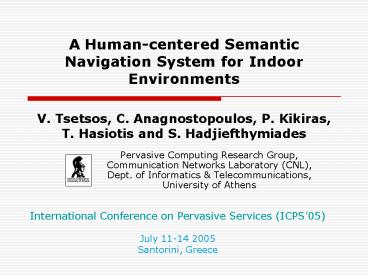A Humancentered Semantic Navigation System for Indoor Environments - PowerPoint PPT Presentation
1 / 20
Title:
A Humancentered Semantic Navigation System for Indoor Environments
Description:
... LBS: A new human-centered approach. Intelligent service provision based on ontological knowledge ... interpretations of distance than the Euclidean one ... – PowerPoint PPT presentation
Number of Views:55
Avg rating:3.0/5.0
Title: A Humancentered Semantic Navigation System for Indoor Environments
1
A Human-centered Semantic Navigation System for
Indoor Environments
V. Tsetsos, C. Anagnostopoulos, P. Kikiras, T.
Hasiotis and S. Hadjiefthymiades
- Pervasive Computing Research Group,
- Communication Networks Laboratory (CNL),
- Dept. of Informatics Telecommunications,
- University of Athens
International Conference on Pervasive Services
(ICPS05) July 11-14 2005 Santorini, Greece
2
Presentation Structure
- Introduction
- System Design
- Conclusions
3
Pedestrian Navigation Systems
- Navigation a typical Location Based Service
- Indoor vs. Outdoor
- Outdoor Navigation has attracted more interest,
partly due to GPS proliferation - Indoor Navigation research is driven by robot
navigation - Pedestrian Indoor Navigation
- Museum guides
- Special solutions for people with disabilities
- Semantic LBS A new human-centered approach
- Intelligent service provision based on
ontological knowledge representation and hybrid
location modeling - Human-centered services, suitable for people with
disabilities - Can be deployed in smart environments
4
Motivation
- Complex and unknown built environments cannot be
easily explored - People with disabilities face additional
difficulties and put extra effort when following
paths that eventually become non-traversable - Built environments are associated with rich
semantics which may lead to intelligent services
if appropriately exploited - OntoNavs goal to assist the path selection and
E2E user guidance by exploiting the semantics of
indoor spaces
5
Use Case (I)
Destination
5 walkable paths
6
Use Case (II)
Destination
2 traversable paths
Best Traversable Path is not the shortest
walkable path
7
Presentation Structure
- Introduction
- System Design
- Conclusions
8
OntoNav Architecture
- Navigation Service (NAV)
- Geometric Path Computation Service (GEO)
- Semantic Path Selection Service (SEM)
9
System Functionality (I)
User-compatible graph
Building graph
Building blueprints (GIS)
Data Migration
Spatial DB
INO instances
User-compatible INO instances
Indoor Navigation Ontology (INO)
User profile (capabilities)
10
System Functionality (II)
User-compatible graph
User profile
GEO
SEM
NAV
k shortest paths
Best Traversable Path
User-compatible INO instances
User and destination locations
11
Indoor Navigation Ontology (INO) I
- Represents complex built environments from a
navigation perspective - Imports concepts from indoor location ontology
- Building, Floor, Room, Corridor,
- no well-established indoor location ontology
exists ? merging and extensions of existing
indoor location models are pursued - INO is currently in evaluation phase
12
Indoor Navigation Ontology (INO) II
13
User profiles
- Describe the capabilities and preferences of
users - A user profile (UP) contains
- Physical navigation rules (e.g., wheelchair)
- Perceptual navigation rules (e.g., child,
illiterate) - Routing preferences (e.g., calendar-based)
- A user typically selects a predefined UP and
further adjusts it - UPs are implemented as sets of rules that refer
to INO vocabulary and are applied to INO
instances - e.g., if user x cannot walk and path p contains a
vertical passage v of type stairs then p is
excluded
14
NAV Service
- Provides the interface between end-users and
OntoNav - Receives user requests
- Retrieves user position and location of
destination - Handles path presentation issues
15
GEO Service
- Inputs
- a planar graph that accumulates the floor
sub-graphs that are traversable by a specific
user - user and destination locations
- Output
- k shortest paths
- Edgescorridor segments, verticesexits and
passages (i.e., each location is reduced to a
set of exits or passages) - Performs hierarchical clustering in the graph on
a floor basis for more efficient path discovery - We cannot promote only the shortest path as it
may not satisfy all user preferences
16
SEM Service
- Inputs
- user profile
- k shortest paths
- Output
- best traversable path (BTP) and its anchors
- BTP is the path that
- satisfies the routing preferences of the user
profile - contains adequate number of appropriate anchors
(landmarks) for its presentation - An anchor is appropriate if it satisfies the
physical and perceptual navigation rules of the
user - Example for a blind or illiterate user the BTP
should contain voice-enabled anchors
17
Implementation Issues
- OntoNav is currently being developed using
- Web Ontology Language (OWL-DL) - navigation
ontology - Semantic Web Rules Language (SWRL) - user
profiles - SweetRules v2.1 - SWRL rules engine
- Racer, Pellet OWL reasoning engines
- PostGIS spatial database
- JUNG Java graph library
18
Presentation Structure
- Introduction
- System Design
- Conclusions
19
Added Value of OntoNav
- A purely user-centric navigation system, that
adheres to the Inclusive Design paradigm - Hybrid location model (geographic and symbolic)
that - Enables more advanced interpretations of distance
than the Euclidean one - Introduces user-defined quality metrics to the
path selection process - Suitable for intelligent context-aware
environments
20
Future Work
- Inference of user status for assistance during
the navigation process - e.g., identification of lost, wandering,
stationary, or deviated users - Study the applicability of path caching
techniques - Deployment on our campus facilities for
evaluation - URL http//p-comp.di.uoa.gr/projects/ontonav































